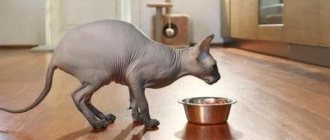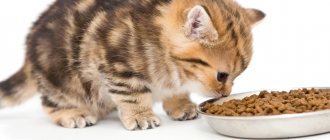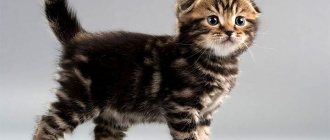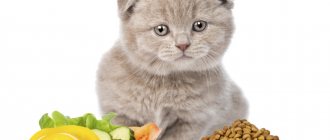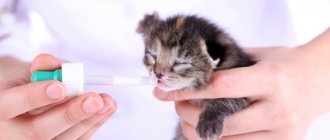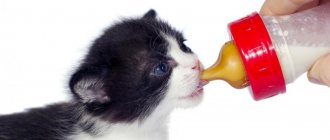In this publication we will look at what and how much to feed a Scottish kitten, and what food is suitable for Scottish kittens. Moreover, contrary to the opinion that if you have a Scottish Fold cat (Scottish Fold or Highland Fold), you need to feed it differently than a straight-eared cat (Scottish Straight and Highland Straight) so that its ears do not stand up, in fact In fact, the same diet is suitable for both varieties of the Scottish breed. Scottish Fold and Straight-eared kittens are at a developmental stage, so the question of what to feed is very important.
Article continues after advertisement
Toilet and tray training
Usually there are no problems with taming to the tray.
In nature, cats bury their feces in the ground, so it is convenient for cats to do their business in a litter tray. Wood or cardboard is preferable as a filler - it does not generate dust and absorbs odors well. Important! To accustom a kitten to the litter box, when the animal first appears at home, you can take it to the house and show it where to go to the toilet.
You can carefully dig your kitten's paw into the litter
If a cat suddenly begins to go to the toilet in the wrong place, you should not scold them. Perhaps the reason is severe stress or poor health. For example, a Scottish cat will never stoop to peeing in a dirty litter box. If the reasons for this behavior are not obvious, an animal psychologist or veterinarian will help to deal with the problem.
Features of a natural diet
A natural diet, according to veterinarians and experienced breeders, is the most beneficial and optimal for the digestive system of a Scottish Straight kitten and involves feeding the pet exclusively with natural products. Advantages of this feeding method:
- high quality and freshness of products;
- affordable, affordable cost;
- great variety and choice;
- the ability to create a diet taking into account the baby’s taste preferences.
Worms in Scottish kittens
If you notice that your kitten has become lethargic, does not want to eat, or, conversely, eats a lot, but is losing weight, with intestinal upset, bloating (and you are feeding correctly), and the kitten fidgeting on the floor on its butt, it is possible. worms (helminths) have appeared.
It is better to deworm a Scottish kitten in 2 stages with an interval of 2 weeks (suspensions, tablets, drops on the withers), with the exception of Profender drops on the withers due to the long period of action. I do not recommend using Prazitel, Prazicide, Drontal (they will most often be offered to you at the pharmacy from inexpensive drugs) due to the increasing frequency of counterfeits and bad reviews from cat owners.
Calculate the dosage strictly according to the kitten’s weight. If you can’t feed your pet a tablet, crushed and mixed with food, then you can use Canikquantel Plus, it is sold in the form of a gel. Give using a syringe without a needle into the corner of the mouth.
After deworming, it is better to give half a teaspoon of Enterosgel, diluted with water, or another sorbent. After the entire procedure, be sure to watch the kitten for the first few hours, it must go to the toilet.
Kittens need to be dewormed once every 3-5 months, especially if they eat raw meat. It is also necessary to undergo this procedure 7-10 days before vaccination!
How often should I feed?
Pedigree Scottish kittens are usually under the care of their mother cat for at least two months. Breastfeeding ensures the development of the immune system in adorable fluffies. In this case, complementary foods are introduced long before the kitten is weaned from mother's milk.
If for some reason a cat is not able to feed her offspring, then the count of feeding the small lumps literally goes on for hours.
It is recommended to adhere to a strict schedule:
- every 2-2.5 hours it is necessary to give milk formula to kittens under 2 weeks of age;
- until 1 month is completed - once every three hours. A one-month-old bottle-fed Scottish kitten will already need water. At the same time, complementary foods can be introduced;
- After the pet turns 2 months old, even if it has a mother cat, it will not be able to do without proper nutrition. The Scotsman should eat about 7 times, during daylight hours;
- 3 months is a turning point for all babies. There is no longer any mother's milk, and you need to feed food at least 6 times a day;
- at 5 months the number of appointments is reduced to 5;
- at 9 – 4 meals a day are enough;
- By 12 months, the Scotsman should get used to the “adult” daily routine: 2 or 3 feedings a day.
General feeding rules
- Breed name: Scottish Fold cat (Scottish Fold).
- Country of origin: Scotland / UK.
- Weight: 4–5 kg.
- Height at withers: up to 30 cm.
- Average life expectancy: up to 15 years.
- Average price: 5–20 thousand rubles.
At the very beginning of their lives, Scottish cat babies feed exclusively on their mother's milk, so feeding such a pet does not cause problems. This period lasts several weeks, after which any breed of cat, including the Scottish Fold, can be fed one of three main types of food:
- exclusively natural and fresh food products;
- dry or jelly-like ready-made food;
- proper mixed diet.
As a replacement for mother's cat's milk, special adapted formulations can be used, as well as some self-prepared mixtures based on:
- 250 ml of concentrated milk, half an egg yolk and a couple of teaspoons of fructose;
- 100 ml cow's whole milk, 30 g whole milk powder and 5.0 g dry yeast;
- 100-110 ml of whole milk, 100-110 g of boiled milk, raw egg yolk and a couple of teaspoons of corn oil.
When choosing a feeding method, it is necessary to take into account the taste preferences of your pet, and also focus on the availability of a sufficient amount of free time required for independent cooking. A kitten aged one and a half to two months should be fed five times a day.
It is also permissible to provide such a pet with free access to food. By about six months, the number of feedings is gradually reduced to three times a day, and starting from eight months, the kitten is transferred to two meals a day. The food given to your pet must be fresh and at a comfortable room temperature. Among other things, the kitten should have access to clean drinking water at all times.
- The basis of the menu should be meat. Natural food or ready-made food: pay close attention to the composition and quality of raw materials.
- Artificial additives, dyes, spices, salt, stabilizers, flavors and sugar are prohibited. By excluding them, you will ensure the natural development and good health of your pet.
- Provide the Scot with water. This is the most important feeding rule.
- Make sure the food is at room temperature and the correct consistency. It is better to give crushed food to Scottish kittens up to 3 months old. Closer to 6 months, they switch to large pieces, which will ensure normal development of the jaw muscles.
The Scots, together with the British, have long dictated the rules of home etiquette. Not only its health depends on how carefully you pay attention to feeding a kitten, and then an adult cat. A satisfied pet who is satisfied with the contents of the bowl will become a source of peace and well-being in your family.
Features of feeding Scottish Fold kittens
Newborn babies happily suck their mother's milk. It is their only food for the first three weeks of life. If the cat does not have milk, it is replaced with infant formula. They are bred according to the instructions on the package and fed to the kitten using a pipette. The baby needs food every 2 hours.
Upon reaching 3 weeks of age, the Scottish Fold kitten begins to receive complementary foods. The interval between meals increases. The cubs eat 5 times per day. Owners need to decide in advance what kind of food the animal will receive in order to properly adapt to it.
If natural nutrition is planned, the baby is given planed boiled beef, raw eggs (yolk), and cream (10% fat) in small portions. Each new product is introduced into the diet separately. At the same time, the owner needs to check how the kitten’s body reacts to complementary foods. Usually the animal switches to the traditional menu a month after the start of complementary feeding.
Do not use minced meat, puree or canned food as an additive. These products are poorly absorbed by the child's body. Negative manifestations may include allergies or diarrhea.
If it is decided to accustom the cat to a special food, then it is softened with water to a mushy state. The resulting consistency is applied to the palate of the baby. This way he can taste the food and get used to it. A two-month-old Scottish Fold kitten is completely switching to dry food.
Special ready-made food: what to prefer
The most important rule in this case is that the food must be “premium class”. Even if such food is more expensive, it will definitely not cause harm and will be beneficial
As for the consistency, breeders especially like to feed their little charges mousse - it is most convenient to eat.
Food for babies must be designed for their age, since pellets for adult animals are larger and, as a result, inconvenient
As for brands, you should pay attention to the following:
- “Hills” - contains phosphorus, magnesium, calcium in excellent balance. It has a medicinal line of foods available, but you should first consult with a veterinarian about the advisability of using them.
- "Royal Canin" - contains enough fiber and an acceptable dosage of quickly digestible proteins. Helps create an optimal balance of intestinal flora and normalize the animal's stool.
- “Innova EVO” is favored by experienced breeders due to its composition of fresh meat and vegetables, oils, minerals, and vitamins. Fats and oils have a good effect on the immunity of kittens, and the absence of harmful impurities and even taste and smell enhancers guarantees high quality food.
- “Matisse” - most of the composition is chicken meat and fat, rice, fish, eggs. In addition, the food contains a whole complex of vitamins and calcium.
Scottish is a breed that attracts with its beauty and dignity
However, for all this, just a good pedigree is not enough - care is also of no small importance. But there is nothing complicated about the issue of proper feeding if you figure it out in advance and don’t improvise on the fly
Previous Scottish Straight (Scottish Straight) Buying a Scottish Straight - selection and prices Next Scottish Straight (Scottish Straight) Health of the Scottish Straight - diseases, prevention, vaccinations and basic information
What should you not feed?
Whatever the fate of the Scottish kitten - with its mother or breastfeeding, there are strict prohibitions on the use of certain categories of products in its diet. After all, the formation of the immune system and all organs in the body lasts almost up to a year. This fact dictates that you carefully weigh what to feed your lop-eared kitten.
The list of unacceptable ones includes:
- Budget food. Remember, you are laying the foundation for health. To keep your Scotsman happy for many years, take care of the professional quality of the food and be prepared for the fact that it will be expensive. Savings on the health of a purebred Scottish kitten will result in large costs for its treatment in the future.
- Bones. Fish or chicken - easily crushed. The kitten can swallow a fragment and injure internal organs.
- Fat meat. Proteins should prevail in the balance of nutrients. Therefore, pork, lamb or fatty poultry are excluded from feeding.
- Fish. Primarily river. Under the strictest prohibition, raw and fatty.
- Cow's milk. In its pure form it can cause stomach upset.
- Raw eggs - due to the danger of salmonella.
- Food from the human table. Spices, sweets, baked goods that have undergone special processing are prohibited: smoked, fried, canned foods. A kitten should not even be given baby food: it also contains added sugar, spices, and vegetables that its body does not accept.
- Medicines for people. It is unlikely that you will be able to measure the dosage, and the active ingredients are designed for humans, and not for predators. For a Scottish kitten, taking them can be dangerous.
Scots are recommended to include fruits, vegetables and grains in their natural diet. There are exceptions among them:
- potatoes, tomato, rhubarb. Not absorbed by the body, causing problems in the gastrointestinal tract;
- legumes Causes digestive problems. Undercooked beans or peas in a kitten will provoke fermentation processes in the intestines;
- citrus. The kitten is unlikely to eat them, but if this happens, indigestion and allergies are possible;
- onion and garlic. The substances in the composition destroy red blood cells. In large quantities they contribute to the development of anemia.
If the owner loves mushrooms, this does not mean that the cat can eat them: the body cannot cope with such a source of protein, and predators do not produce enzymes to digest them.
Eye treatment
Not only Scots, but also representatives of any breed, at such a young age need sensitive care and care from their caring owners. Just like the ears, the eyes need regular examination and treatment. A disinfectant solution applied to a cotton pad will help prevent infection from entering the eye mucosa and the development of an inflammatory process.
Owners should know that if a cat constantly tries to scratch its eye with its paw, shakes its head, and its visual organs are tearing or festering, it is urgent to contact a specialist. There may be a foreign body in the eyes of a kitten or an adult animal. The cause of such symptoms can also be an infectious disease such as conjunctivitis, keratitis, blepharitis, and so on. All these pathological conditions require long-term and high-quality treatment.
Feeding “natural”: how to prepare food?
Cooking Scottish food takes a little time. Dietary meat is served raw, after preliminary freezing (low temperatures destroy helminths). It is not worth boiling the fillet parts of carcasses for your pet: the maximum part of the nutrients is absorbed from raw foods, and food familiar to humans will simply clog the animal’s stomach.
The best option is to cut the prepared thawed steak into small pieces, first removing the bones.
It is recommended that meat food for the Scottish Straight be supplemented with offal (beef heart, kidneys, chicken stomachs). But whether to give your pet fish is a controversial issue: its frequent consumption can cause kidney and urinary tract diseases. Ocean treats can be present in a cat's diet no more than once a week. Giving river fish is allowed only after boiling in order to avoid infecting your pet with parasites.
Cottage cheese with a fat content of no more than 6%, kefir settled at room temperature should be eaten daily by a pet. It is recommended to mix cereal products (dried bread, rice porridge) with meat, adding egg yolk to the main portion a couple of times a week.
The breed, originally from Scotland, is captivating more and more people. The cute appearance and good character encourage many to adopt this furry miracle. However, the first thing you should familiarize yourself with is information about how to choose the right food for a Scottish Straight kitten.
Description of feed
There are several food options suitable for Scottish Folds, namely:
- dry;
- wet and semi-moist.
Dry food is rightfully recognized as the most popular. The granules that make up such products have a long shelf life. They do not need to be prepared, boiled or stewed first - they are immediately poured into bowls and after that they can be eaten. The main thing is to remember that such treats should not be given to very young kittens.
While Scots babies still have milk teeth, they will not be able to chew granules normally. When teeth become loose and replaced, gums can be severely damaged by eating such foods
When the teeth have already erupted and are growing, dry food can lead to damage to the bite and curvature of the incisors - this is very important to consider
Sometimes kittens (this also happens with adult cats) do not chew the granules, but immediately swallow them whole. There is nothing good from such meals. As a result, this can lead to a number of problems:
- overeating - until the granules become voluminous with the required amount of moisture, the animal will not feel full, even if the portion was calculated correctly;
- bloating;
- constipation due to dehydration.
For adults, dry food is perfect. Not only do they nourish the animals, but they also work like a toothbrush, cleaning their teeth as well as massaging their gums. Dry food granules are often used to reward mustachioed friends during training and various educational processes.
But dry food used as the main diet will necessarily require a large fluid intake from the cat. The Scotsman will have to drink a lot, otherwise certain problems associated with the digestive system will arise. That is why owners should not forget about regularly changing the water - it should always be fresh and clean.
The second most popular are wet and semi-moist foods for cats. This diet differs from the dry diet described above by its significant liquid content. This type of treat is more suitable for Scots because it does not force cats to consume large quantities of water. True, these products have one drawback - sometimes their regular consumption ends in loosening of the gums, due to the absence of hard pieces.
There are two types of wet food:
- pates;
- pieces with gravy.
For a permanent diet, it is recommended to purchase premium and super-premium food categories. If you are selecting a product for a castrated or sterilized cat, then you need to buy only premium options.
Feeds of these classes contain vitamin complexes, protein and other necessary components. True, such food costs more. Some varieties of premium food can only be found in rare pet stores. Many manufacturers of such treats produce separate medicinal lines of food that should be given to animals as prescribed by a veterinarian.
Premium food is much better than that of the economy class. As a rule, they can be given to cats every day without fear for their health. The same cannot be said about cheap products.
Separately, it is worth highlighting cat food that belongs to the holistic class. Such products are rightfully recognized as the highest quality and in most cases are made only from natural ingredients. They are expensive, but do not harm the health of Scottish Folds. It is worth noting that the prevalence of these products is not the greatest, especially in comparison with budget feeds.
List of prohibited products
It is important to exclude prohibited foods from the Scottish Straight kitten's diet:
- Bones, pure fat, skin, especially poultry. Palm oil. Grapes, raisins. Juicy and sweet fruits. Soy. Mushrooms. Corn and semolina. Raw freshwater fish. Dry, salted fish. Products containing sugar or sugar substitutes. Products containing xylitol (chewing gum, some sweets). Products containing flour or yeast. Products containing caffeine, cocoa, any stimulants (sweets, tea, coffee, chocolate). Products containing marinades, salt, spices. Smoked products, including sausages, balyki, fish. Expired products. Leftovers from the table.
Controversial foods in the diet of a Scottish Straight kitten are:
- Fresh pork is a source of helminths and false rabies. Raw ocean fish are a source of helminths. Whole milk – risk of individual intolerance. Chicken eggs are an allergen. Factory-bred chicken – risk of allergies and individual intolerances. Raw and boiled chicken liver in large quantities. Cereals.
Advice! All products that can become a source of helminth infection must be boiled or pre-frozen for 4-5 days. Controversial foods are introduced into the diet gradually, monitoring the body's reaction.
Scottish Shorthair cat - features of the breed
Before getting an animal, especially a blue-blooded cat, you should know all the characteristics of the breed.
It just so happens that when choosing a pet, potential owners pay attention only to the positive aspects of the breed, without taking into account the nuances of care and possible problems
The Scottish cat is a very common breed. Unfortunately, the more popular the breed, the more amateur breeders sell kittens with poor genetics. Such kittens are sold cheaper than their counterparts with documents. In addition, many potential owners choose pets solely based on appearance, for example, the shape of the ears or color.
The Scottish cat breed is divided into two large groups:
- Shorthair – stay and fold variety.
- Longhair (Highland) - stay and fold variety. Note that, by and large, Highlands are a completely different breed that has common roots with Scottish Shorthair cats.
Scottish cats are sociable, independent, clean and attractive. Cats with good heredity rarely develop health problems.
Amateur-bred animals often suffer from food allergies, skin problems, diseases of the musculoskeletal system and the cardiovascular system. Naturally, among shorthaired Scots, Fold kittens are more popular.
Scottish Fold kittens - features
Scottish fold kittens (folds), in theory, differ from their straight-eared counterparts only in the shape of their ears. In practice, everything is much sadder. Fold kittens are in high demand, so unscrupulous sellers use various tricks to increase their income. In the best case, kittens' ears are glued or pressed to the head with tight bandages. The ear cartilage does not form correctly and the kitten is called a fold. In this case, nothing threatens the animal’s health, except that there is a risk of developing chronic otitis media.
In the worst case, unscrupulous breeders breed two fold-eared parents. Kittens from such mating are disabled from birth. It is only a matter of time before animals develop malformations of the musculoskeletal system.
Some kittens from these litters are born with deformed hind legs and are unable to walk. In others, the deformities may appear later, leading to chronic pain or paralysis of the hind limbs. Unfortunately, if a kitten is born from a fold + fold mating, no amount of care or even the highest quality nutrition will change the situation.
Scottish straight kittens
Scottish straight-eared kittens (straights) do not have the vicious gene for lop ears, so nothing threatens the health of their musculoskeletal system. The breeder will warn you about the risk of allergies (if you buy a kitten from a reputable seller), and the babies will be examined for other ailments before sale.
Combined nutrition
A combination of industrial and natural food, called a mixed or combined diet, is not the best option for feeding Scottish Straight kittens. When combining different products, various adverse effects are possible:
- metabolic disorders;
- disturbances in the functioning of the gastrointestinal tract;
- chronic diseases of the digestive system.
The only acceptable combination option is the use of dry, semi-moist and wet food when choosing a ready-made diet.
Natural nutrition for Scottish fold or straight-eared kittens and adult animals
This type of feeding is not easy and requires a certain amount of time to prepare food, which is not always convenient or possible.
List of main products that are allowed for Scottish cats:
- Frozen raw beef
(babies from 3-4 months can be given 30 grams per day). - Boiled chicken meat (breast).
- Boiled liver
, but not more than once a week. Otherwise, overuse of this product may lead to stomach upset. - Contrary to existing opinions that fish
, it is not recommended to give it to a Scot; in some exceptions, once a week, low-fat varieties, but in boiled form:
perch, hake or carp
. An excess of this product can lead to kidney disease, since fish belongs to the category of quickly digestible proteins. - Several times a week, low-fat kefir or cottage cheese, fermented baked milk and sour cream
are a real delicacy for the Scots. - Boiled chicken yolk
. - boiled milk and porridge
in the diet of Scots only
for up to 5 months
, otherwise they will cause stomach upset. - Cereals and vegetables
are carbohydrates that are simply necessary for the vital energy of your furry pet. Cereals such as semolina, buckwheat, oatmeal and rice can be mixed with meat or fish and given several times a week. - Boiled or steamed vegetables
: cauliflower, carrots, green beans are pureed and mixed with meat.
Fermented milk products should not be combined with porridge, meat or vegetables, otherwise they will be poorly digested. They can only be combined with eggs and bran.
The main percentage of products when feeding a Scottish cat naturally should be meat products, because they contain protein, which is necessary for the normal functioning of the body: heart muscle, good vision, reproduction, etc.
Microelements, vitamins and supplements
Dietary supplements must be included in the pet’s diet throughout the entire period of feeding natural products. Kittens under 6 months of age need a source of vitamins D and A, that is, fish oil. In addition, chain veterinary pharmacies offer a huge selection of multivitamin preparations for cats and kittens of the Scottish breed and simply as a species of animal.
Your pet must always have fresh, clean water. Ideally, you need to change the water 2 times a day. You can allow your pet to drink water from the tap; the Scottish breed especially loves this.
Approximate nutrition menu for 1 kg of body weight of a Scottish fold or straight-eared cat
Recipe 1:
- lean fresh beef (pour boiling water) – 25 gr.;
- light – 5 g;
- clean water – 10 g;
- vegetable oil – 2 g;
- dry ordinary tremors - 0.2 g;
- plain oat flakes – 4 gr.
Recipe 2:
- fresh liver – 10 g;
- lean fish – 25 gr.;
- buckwheat – 4 gr.;
- plain water – 7 g;
- regular dry yeast – 0.1 g;
- low-fat cottage cheese – 3 gr.
Once you've made the recipe, you can portion it out and freeze it for later. So at any time, after defrosting, you can quickly feed your pet natural food.
Prohibited foods for Scottish Fold and Straight-eared cats:
- pork, smoked, salted, peppered, dried, fresh meat;
- fats;
- floury, sweet.
If food, which one should I choose?
The use of ready-made food makes the feeding procedure easier; owners do not need time to prepare food and select products. Depending on the consistency and packaging, types of food are distinguished:
To avoid unpleasant consequences for the body (vomiting, diarrhea), it is better to use food of the same brand. For purebred cats, experienced breeders recommend turning to products from well-known manufacturers:
- Royal Canin;
- Acana;
- Earthborn Holistic, Primitive Feline Natural Cat Food.
They produce super-premium and premium food that is well absorbed by the body. Economy options (Whiskas, Kiteket, etc.) are less suitable for the daily diet of pets.
Under no circumstances should you mix dry and wet food. For good absorption of dry concentrates, the animal requires more liquid. Fresh, clean water must be readily available at all times.
Menu Basics
For any cats, including Scottish Straights, there are 3 types of food:
- natural feeding;
- feeding with prepared dry or wet food;
- mixed feeding, in which the diet contains both natural products and ready-made mixtures.
There is no clear answer to the question of which feeding is more rational - each type of menu design will be correct, so you should make a decision based on your pet’s taste preferences and the availability of free time. Keep in mind that feeding “natural” requires some time to find and prepare all the products necessary for a balanced diet for the cat.
When feeding “natural”, 70% should be pre-frozen beef or white meat chicken breasts. Once a week you can add offal - it is best to take the liver and heart; you should not introduce them into the diet more often - in this case, your pet may develop indigestion.
There is an opinion that all cats benefit from fish. This is not entirely true, even ordinary “yard” breeds should not be given this product more than once a week, and Scots can only be given low-fat varieties (carp and hake) in boiled form, in small quantities and no more than once every 10-14 days.
Another common misconception is that cats love milk. The fact is that the fluffy’s body secretes the enzymes necessary for the assimilation of this product only until the kitten reaches two months of age. Therefore, in older cats, milk is simply not digested and creates a burden on the digestive organs. However, low-fat cottage cheese, sour cream, fermented baked milk or kefir are exceptionally beneficial for animals - you should definitely give them to your pets once a week.
From time to time you can offer the Scots boiled chicken yolk - two a week will be enough. Cereals are very important for cats; they are a source of energy, vitamins and minerals. Cereals such as oats, buckwheat, semolina and oatmeal are rich in carbohydrates, so they are mixed with meat and given to animals every day. If possible, you can supplement the mash with steamed vegetables - carrots, zucchini, cauliflower or green beans.
There are several taboos when feeding Scottish cats; compliance with them is very important for the health of the animals.
- You should not overfeed your pet - this is a very common mistake that Scottish owners make: many believe that kittens need a lot of food in order for them to grow and develop. This is not true - the fact is that cats of this breed do not know when to stop and often eat more than they need, so the amount of product received must be controlled.
- Any salted, smoked, spicy or fried food is prohibited - any food “from your own table” that seems tasty and healthy to people is too heavy for the furry body and can lead to the development of various pathologies of internal organs.
- Under no circumstances should cats be given bones; they can injure the animal and even lead to death. However, bone meal can be included in the diet from time to time.
- Pork and other fatty foods should be completely excluded from the menu.
Water in a kitten's diet
Water plays an important role in metabolism and the process of hematopoiesis. Dehydration immediately triggers a complex of consequences that help save life, but place increased stress on all organs.
Note! If severely dehydrated, the kitten will die within 24 hours.
Be sure to make sure that the kitten has free access to water. If necessary, place several drinking bowls in your home. Make sure that the water in the drinking bowls is clean and fresh, since standing water is a breeding ground for bacteria.
Appearance
The Fold cat has gained popularity due to the fact that it has a gentle character and beautiful appearance. The animal has a rounded head and a firm chin. The cat's jaw is powerful, extending into a small neck. The cat has beautiful round eyes, their shade goes well with the coat.
Cats have a short nose, but at the same time wide. If you look at the pet, its profile is streamlined and soft. The cat's ears point forward and are triangular in shape. The tips of the ears are slightly rounded.
The body of the Scottish Fold cat is medium-sized, strong and muscular. The pet does not look like he has extra pounds. The cat has rounded paws. The tail is long or medium in size and proportional to the body. Cats are a little more than cats.
Features of nutrition in adolescence
Until 8-10 months, food for Scottish Fold cats is selected specially, marked “for kittens”. After this, you can gradually switch to “adult” food.
By this time, you need to decide on the timing of castration or include your Scottish Straight or Scottish Fold in the mating program.
If the kitten does not participate in breeding, then castration is the only way for a purebred animal to live a long and happy life. However, before surgery, he must be switched to food for neutered pets. Gently and gradually so as not to cause stress. Subsequently, feed only special diets that take into account the characteristics of mature cats, but lacking basic instinct.
With natural feeding, the transition period is marked by the opportunity to feed the pet more fermented milk food. After 10 months, the ears have already formed and the exterior has stabilized. Therefore, calcium will only be beneficial.


